Rottweiler Education
Rottweiler
A Rottweiler is a large dog breed originating in Germany as herding dogs. The early Rottweilers also worked as beasts of burden, carrying wood and other products to market. In addition, they were used as draft animals to pull carts filled with various products for their owners. During the first and second World Wars, Rottweilers were put into service as war time guard dogs. Currently they are frequently used as guard and police dogs.
Classifications
FCI: Group 2 Section 2 #147
AKC: Working
ANKC: Group 6 (Utility)
CKC: Group 3 – Working
KC (UK): Working
NZKC: Utility
UKC: Guardian Dog
Rottweiler appearance
Build: Massive, powerful, muscular
Weight: 75-130 pounds (43-59 kg.)
Height: 24-28 inches (61-69 cm.)
Coat: Short, hard and thick
Color: Black and rust or black and a brownish color
Head: Broad, with rounded forehead and strong muzzle
Teeth: Scissors bite
Eyes: Dark, or an orangey brown
Ears: Triangular, carried forward, occasionally folded slightly
Tail: Was usually docked. Docking is Banned in Germany and U.K. An un-docked rottweiler tail is usually around 4-6 inches and thick.
Limbs: Straight, with heavy bone
Feet: Round, compact, with thick, hard pads
Life span: Median 10-12 years
The breed is almost always black with clearly defined tan or mahogany markings on the cheeks, muzzle, chest, legs, and eyebrows. The coat is medium length and consists of a waterproof undercoat and a coarse top coat. Rottweiler coats tend to be low maintenance, although they experience shedding during certain periods of the year. The skull is typically massive, but without excessive jowls.
Size
According to FCI standard, the Rottweiler stands 61 to 68 cm (24-27 inches) at the withers for males, and 56 to 63 cm (22-25 inches) for females. Average weight is 50 kg for males and 42 kg for females.
Rottweiler Anatomy
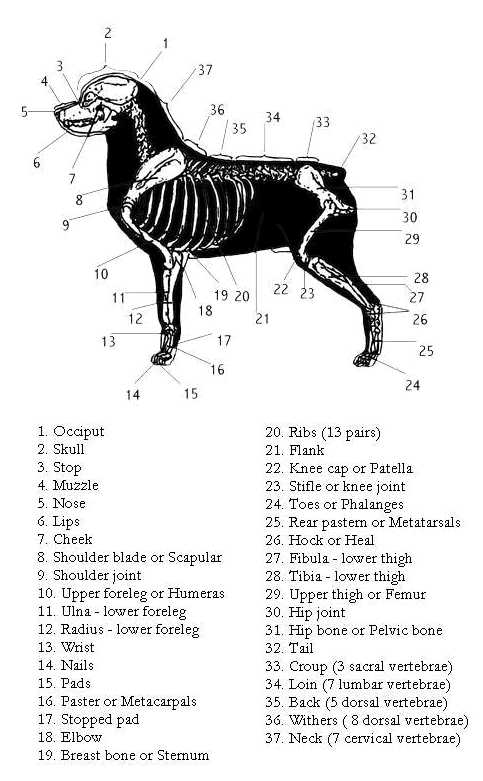
DENTAL ANATOMY OF DOGS
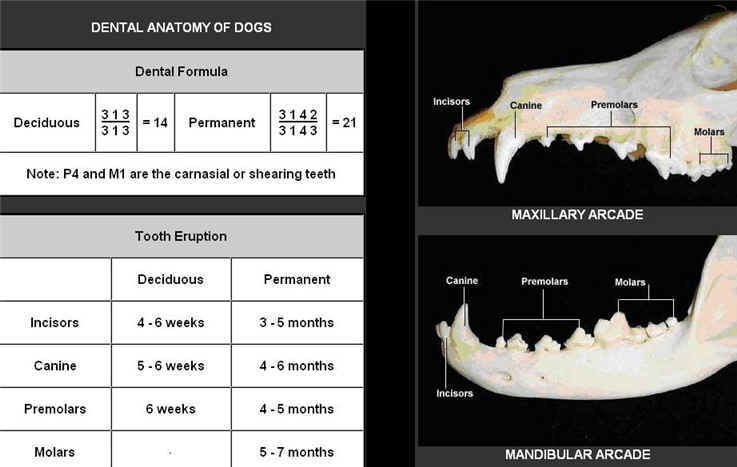
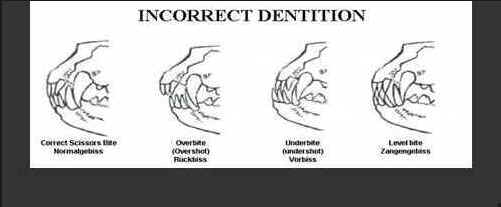
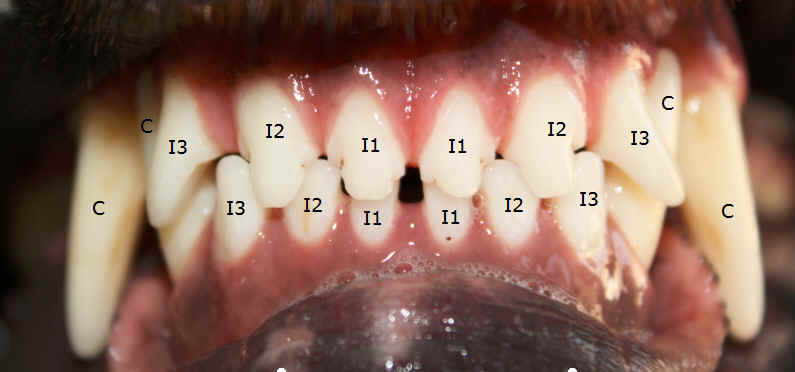
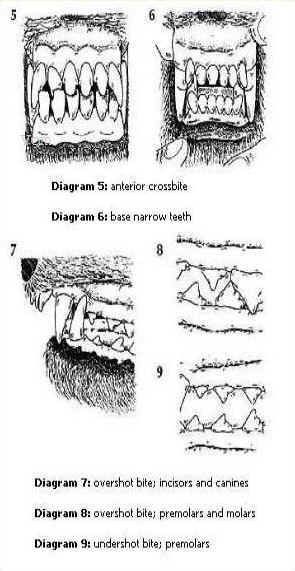
Rottweiler Tail
As of June 1, 1998, a federal law was passed in Germany prohibiting the docking of Rottweiler tails.The basis for this law was
the fact that the practice of docking and cropping was deemed to be inhumane.
In order to comply with the new federal law requiring tails to be left in their natural state, the ADRK (national breed club in
Gemany) revised their breed standard for the Rottweiler to reflect the required natural tail.
TAIL: In natural condition, level in extension of the upper line; at ease may be hanging. Faults: Set on too high or too low.
Disqualifying faults: Kink tail, ring-tail, with strong lateral deviation.
The FCI translated and adopted the new breed standard and gave all FCI member countries several years to comply with the
new
breed standard.
As more and more countries are adopting the anti-docking platform for Rottweilers in order to comply with the revised
ADRK/FCI Standard, and tails are becoming more commonplace, it is very important to become familiar with both the good
and bad tailsets out there. Below are illustrations of those tailsets
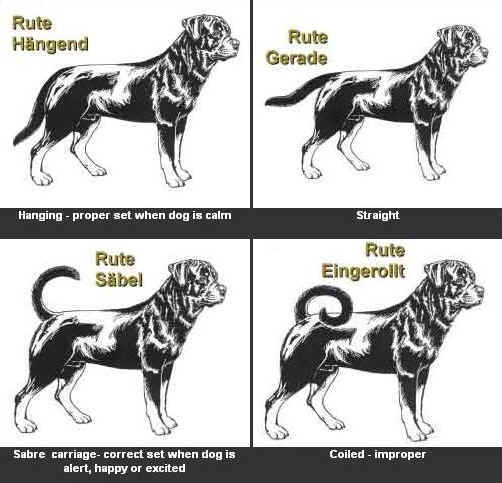
Rottweiler Hips
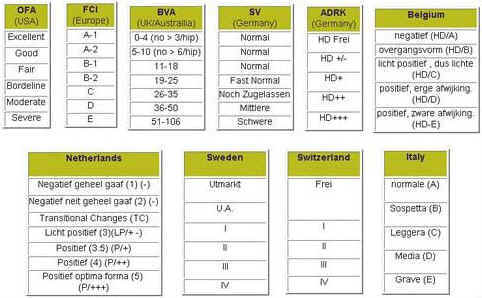

Rottweiler Eye Color
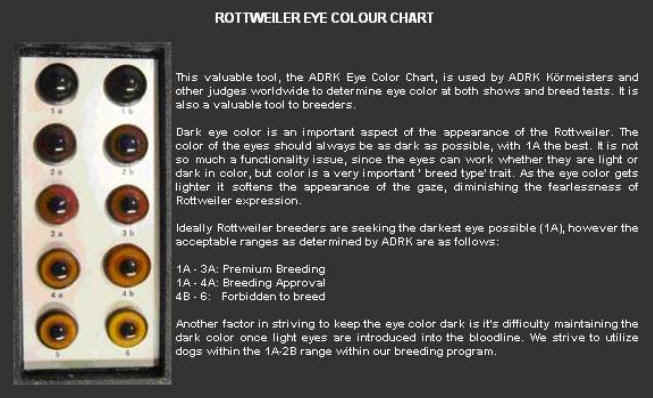
FCI Standard for Rottweilers
ORIGIN: Germany
UTILIZATION: Companion, service and working dog
FCI CLASSIFICATION: Group 2 (Pinscher and Schnauzer type, Molossian type, SwissMountain- and Cattle Dogs and other
breeds).
Section 2.1: Molossian type, Mastiff type. With working trial.
BRIEF HISTORICAL SUMMARY:
The Rottweiler is considered to be one of the oldest dog breeds. Its origin goes back to Roman times. These dogs were kept as
herder or driving dogs. They marched over the Alps with the Roman legions, protecting the humans and driving their cattle. In
the region of Rottweil, these dogs met and mixed with the native dogs in a natural crossing. The main task of the Rottweiler
now became the driving and guarding of the herds of cattle and the defence of their masters and their property.
This breed acquired its name from the old free city of Rottweil and was known as the Rottweil butcher’s dog’. The butchers
bred this type of dog purely for performance and usefulness. In due course, a first rate watch and driving dog evolved which
could also be used as a draught dog. When, at the beginning of the twentieth century, various breeds were needed for police
service, the Rottweiler was amongst those tested. It soon became evident that the breed was highly suitable for the tasks set
by police service and therefore they were officially recognized as police dogs in 1910.
Rottweiler breeders aim at a dog of abundant strength, black coated with clearly defined rich tan markings, whose powerful
appearance does not lack nobility and which is exceptionally well suited to being a companion, service and working dog.
GENERAL APPEARANCE: The Rottweiler is a medium to large size, stalwart dog, neither heavy nor light and neither leggy nor
weedy. His correctly proportioned, compact and powerful build leads to the conclusion of great strength, agility and endurance.
IMPORTANT PROPORTIONS: The length of the body, measured from the point of the sternum (breast-bone) to the ischiatic
tuberosity, should not exceed the height at the withers by, at most, 15 %.
BEHAVIOUR/TEMPERAMENT: Good-natured, placid in basic disposition and fond of children, very devoted, obedient,
biddable and eager to work. His appearance is natural and rustic, his behaviour self-assured, steady and fearless. He reacts to
his surroundings with great alertness.
HEAD:
CRANIAL REGION:
Skull: Of medium length, broad between the ears. Forehead line moderately arched as seen from the
side. Occipital bone well developed without being conspicuous.
Stop: Well defined
FACIAL REGION:
Nose: Well developed, more broad than round with relatively large nostrils, always black.
Muzzle: The foreface should appear neither elongated nor shortened in relation to the cranial region. The muzzle and top scull should be a 60/40 ratio and not shorter.
Straight nasal bridge, broad at base, moderately tapered.
Lips: Black, close fitting, corner of the mouth not visible, gum as dark as possible.
Jaws/Teeth: Upper and lower jaw strong and broad. Strong, complete dentition (42 teeth) with scissor
bite, the upper incisors closely overlapping the lower incisors.
Cheeks: Zygomatic arches pronounced.
Eyes: Of medium size, almond-shaped, dark brown in colour. Eyelids close fitting.
Ears: Medium-sized, pendant, triangular, wide apart, set on high. With the ears laid forward close to the
head, the skull appears to be broadened.
NECK: Strong, of fair length, well muscled, slightly arched, clean, free from throatiness, without dewlap.
BODY:
Back: Straight, strong, firm.
Loins: Short, strong and deep.
Croup: Broad, of medium length, slightly rounded. Neither flat nor falling away.
Chest: Roomy, broad and deep (approximately 50 % of the shoulder height) with well developed forechest
and well sprung ribs.
Belly: Flanks not tucked up.
TAIL: In natural condition, level in extension of the upper line; at ease may be hanging.
LIMBS:
FOREQUARTERS: Seen from the front, the front legs are straight and not placed too closely to each other. The
forearm, seen from the side, stands straight and vertical. The slope of the shoulder blade is about 45 degrees to
the horizontal.
Shoulders: Well laid back.
Upper arm: Close fitting to the body.
Forearm: Strongly developed and muscular.
Pasterns: Slightly springy, strong, not steep.
Front feet: Round, tight and well arched; pads hard; nails short, black and strong.
HINDQUARTERS: Seen from behind, legs straight and not too close together. When standing free, obtuse angles are formed
between the dog’s upper thigh and the hip bone, the upper thigh and the lower thigh, and the lower thigh and metatarsal.
Upper thigh: Moderately long, broad and strongly muscled.
Lower thigh: Long, strongly and broadly muscled, sinewy.
Hocks: Sturdy, well angulated hocks; not steep.
Hindfeet: Slightly longer than the front feet. Toes strong, arched, as tight as front feet.
GAIT: The Rottweiler is a trotting dog. In movement the back remains firm and relatively stable. Movement
harmonious, steady, full of energy and unrestricted, with good stride.
SKIN: Skin on the head should be overall tight fitting. When the dog is alert, the forehead may be slightly wrinkled.
COAT:
Hair: The coat consists of a top coat and an undercoat. The top coat is of medium length, coarse, dense
and flat. The undercoat must not show through the top coat. The hair is a little longer on the hindlegs.
Colour: Black with clearly defined markings of a rich tan on the cheeks, muzzle, throat, chest and legs, as
well as over both eyes and under the base of the tail.
SIZE AND WEIGHT :
MALES:
Height: at withers is 61 – 68 cm
61 – 62 cm is small
63 – 64 cm medium height
65 – 66 cm is large (correct height)
67 – 68 cm is very large
Weight: 50 kg
BITCHES:
Height: at withers is 56 – 63 cm
56 – 57 cm is small
58 – 59 cm medium height
60 – 61 cm is large (correct height)
62 – 63 cm very large
Weight: Approximately 42 kg
FAULTS: Any departure from the foregoing points should be considered a fault and the seriousness with which the fault should
be regarded should be in exact proportion to its degree.
General appearance: Light, weedy, leggy appearance. Light in bone and muscle.
Head: Hound-type head. Narrow, light, too short, long or coarse head. Flat forehead (lack of stop or too little stop).
Foreface: Long or pointed muzzle; split nose; Roman nose (convex nasal bridge) or dish-faced (concave nasal bridge); acquiline
nose; pale or spotted nose (butterfly nose).
Lips: Pendulous, pink or patchy; corner of lips visible.
Jaws: Narrow lower jaw.
Bite: Pincer bite.
Cheeks: Strongly protruding.
Eyes: Light, deep set. Also too full and round eyes; loose eyelids.
Ears: Set on too low, heavy, long, slack or turned backwards. Also flying ears or ears not carried symmetricaly.
Neck: Too long, thin, lacking muscle. Showing dewlap or throaty.
Body: Too long, too short or too narrow.
Back: Too long, weak; sway back or roach back.
Croup: Too sloping, too short, too flat or too long.
Chest: Flat-ribbed or barrel-shaped. Too narrow behind.
Tail: Set on too high or too low.
Forequarters: Narrow or crooked front legs. Steep shoulder placement. Loose or out at elbow. Too long, too short or too
straight in upper arm. Weak or steep pastern. Splayed feet. Too flat or too arched toes. Deformed toes. Light coloured nails.
Hindquarters: Flat thighs, hocks too close, cow hocks or barrel hocks. Joints with too little or too much angulation. Dewclaws.
Skin: Wrinkles on head.
Coat: Soft, too short or long. Wavy coat; lack of undercoat.
Colour: Markings of incorrect colour, not clearly defined. Markings which are too spread out.
ELIMINATING FAULTS:
Behaviour: Anxious, shy, cowardly, gun-shy, vicious, excessively suspicious, nervous animals.
General: Distinct reversal of sexual type, i.e. feminine dogs or masculine bitches.
Teeth: Overshot or undershot bite, wry mouth; lack of one incisive tooth, one canine, one premolar or one molar.
Eyes: Entropion, ectropion, yellow eyes, different coloured eyes.
Tail: Kink tail, ring-tail, with strong lateral deviation.
Hair: Definitely long or wavy coat.
Colour: Dogs which do not show the typical Rottweiler colouring of black with tan markings. White markings.
Any dog clearly showing physical or behavioural abnormalities shall be disqualified.
NB : Male animals should have two apparently normal testicles fully descended into the scrotum.
More on the Rottweiler Tail
What is a Breed Standard?
For each breed of dog, there is a breed standard which is a word description of the perfect dog of that breed. Standards describe the mental and physical characteristics that allow each breed to perform the function for which they were originated. The standard describes the dog’s looks, movement and temperament. Breeders involved with each breed are attempting to produce a dog that most closely conforms to the breed standard. In this respect, dog shows are not unlike cat shows, bird shows, cattle shows, horse shows, etc. In fact, for almost every species bred by man there are competitions among breeders. Licensed judges examine the dogs and place them in accordance to how close each dog compares with their mental image of the “perfect” dog as described in the breed’s official standard.
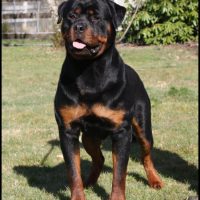
The FCI (Fédération Cynologique Internationale) is the World Canine Organization. It has 80 members, almost every country in the world has a Kennel Club that is a member. One National Kennel Club is recognized from each country (the AKC in the US) and that National Kennel Club issues their own pedigrees and trains and licenses their own judges. The FCI also mandates breeding rules and a Code of Ethics to be followed by breeders of each member country.
The FCI recognizes 337 breeds, each of them is the ‘property’ of a specific country (normally the country of origin). The ‘owner’ countries of the breeds write the breed standard for their breed and the adoption, translation and updating of the standards is carried out by the FCI. The Rottweiler originated in Germany and the ADRK (Allgemeiner Deutscher Rottweiler Klub has the right and responsibility to set, maintain and revise the breed standard for the Rottweiler for the rest of the world.
Why do Rottweilers now have natural tails?
In 1999 the country of Germany passed a law that made it illegal to dock a dog’s tail or crop a dog’s ears. The basis for this law was the fact that the practice of docking and cropping was deemed to be inhumane treatment of animals.
In order to comply with the new law, the ADRK revised the Breed Standard for the Rottweiler and this new breed standard required a natural tail. The FCI translated and adopted the new breed standard and gave all FCI member countries several years to comply with the new breed standard.
A docked Rottweiler does not conform to the current FCI breed standard. As each FCI member country finalizes their adoption of the new breed standard Rottweiler breeders in those countries will no longer be allowed to dock and docked Rottweilers will be disqualified at shows and prohibited from breeding.
The AKC (American Kennel Club) is not a member of the FCI. AKC does not follow any of the rules and regulations set by the FCI for the rest of the world and they do not always follow the breed standards set by the countries of origin. The AKC Breed Standard for the Rottweiler has always deviated from the FCI standard and they are currently struggling to deal with the breed standard regarding the tail.
There are a number of Rottweiler breeders in the United States that follow the FCI Code of Ethics for breeding and strictly follow the FCI/ADRK Breed Standard for the Rottweiler and those breeders will all leave natural tails on their dogs.
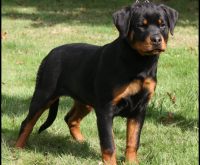
American Veterinary Medical Association Position Statement on Tail Docking
(Current as of June 2005)
Ear cropping and tail docking in dogs for cosmetic reasons are not medically indicated nor of benefit to the patient. These procedures cause pain and distress, and, as with all surgical procedures, are accompanied by inherent risks of anesthesia, blood loss, and infection. Therefore, veterinarians should counsel dog owners about these matters before agreeing to perform these surgeries
The World Small Animal Veterinary Association’s position on tail docking
The WSAVA considers amputation of dogs’ tails to be an unnecessary surgical procedure and contrary to the welfare of the dog. The WSAVA recommends that all canine organizations phase out any recommendations for tail amputation (docking) from their breed standards. The WSAVA recommends that the docking of dogs’ tails be made illegal except for professionally diagnosed therapeutic reasons, and only then by suitably qualified persons, such as registered veterinarians, under conditions of anesthesia that minimize pain and stress.
What is tail docking?
Tail docking today is the amputation of a dog’s tail at varying lengths to suit the recommendations of a breed Standard. Docking involves the amputation of the puppy’s tail either with scissors, a knife or with a rubber band. The cut goes through many highly sensitive nerves in the tissues including skin, cartilage, and bone. This procedure is usually performed without any anesthetic at between three to five days of age. The procedure can be performed by either a registered veterinary surgeon or by an experienced dog breeder. In many countries veterinarians are declining to perform this unnecessary procedure, meaning that breeders are now docking more dogs.
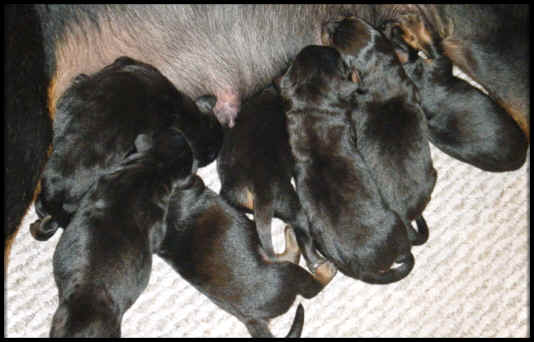
Is tail docking painful for the puppy?
Yes, there is strong evidence that this is the case. The puppy has a fully developed nervous system and a well-developed sense of pain. Puppies scream during the procedure and they whimper, whine and cry for 2-3 days following docking. During the recovery stage they do not eat well and gain less weight than undocked puppies. Many veterinarians condemn the practice and refuse to perform the procedure because it is totally unnecessary and can lead to serious complications. Some veterinarians continue perform tail amputation reluctantly in order to keep the procedure under professional supervision, please their clients and to minimize the risk to the pups.
Does tail docking prevent tail injuries?
The vast majority of dog breeds have natural tails. There is no movement in natural tailed breeds to remove the tail in order to prevent injuries. When tails remain intact, there are no more tail injuries in breeds that were customarily docked than in other breeds of dog.
Can docking cause problems in later life?
There is considerable scientific evidence that docking can lead to complications, including hemorrhage, infection and occasionally death of the puppy. In later life the stump of the tail may be painful due to the formation of neuroma (nerve tissue scar) in the stump. This also occurs following amputation of limbs in people and causes considerable discomfort. Dogs have evolved into their current shape over many thousands of years. If a tail were not useful to a dog, natural selection would have eliminated it long ago. Indeed, tails have many useful functions and are important for balance and body language among other things.
Are tailed Rottweilers different?
Certainly not! In fact once people get used to seeing dogs with their natural tails, the docked dogs look strange, like something is missing. Once you own a tailed Rottweiler it is hard to understand why the tails of this breed were ever amputated in the first place. They use their tails for balance and agility and most importantly, expression and communication. Try to imagine if the reverse happened and you saw a breed such as Labrador retriever with a docked tail. The dog would look quite strange without a tail and you would wonder why the procedure was done.
